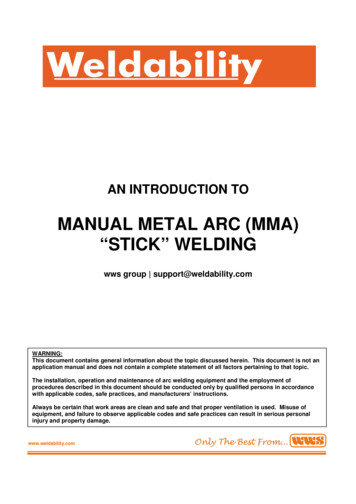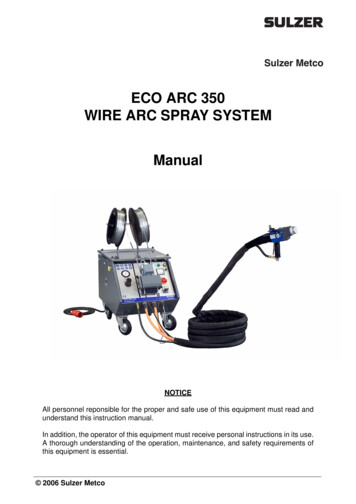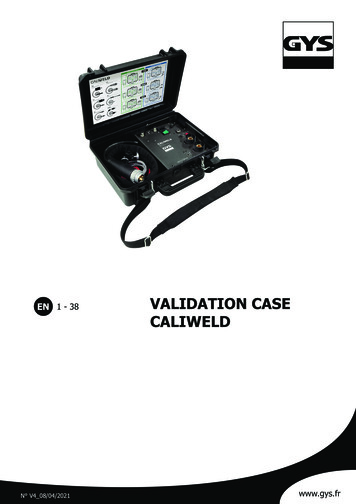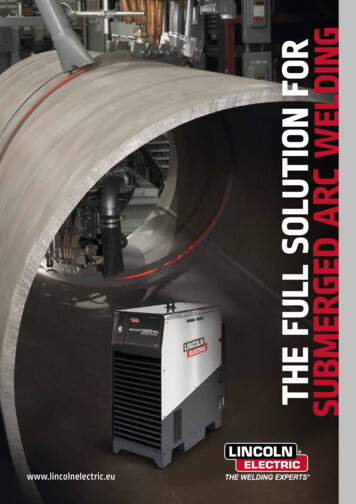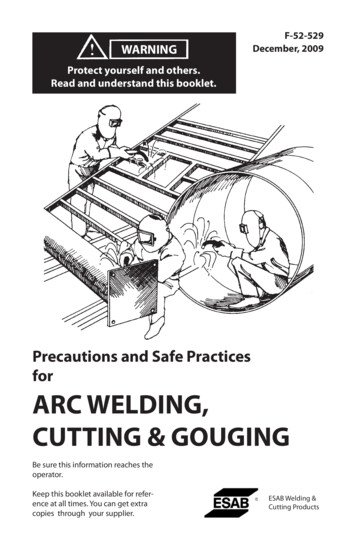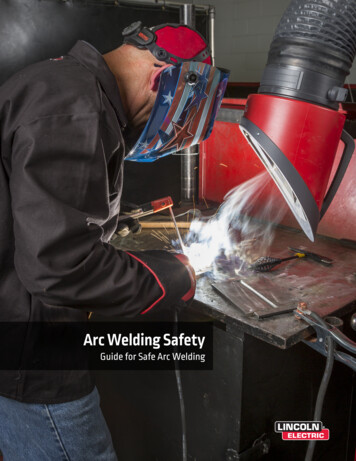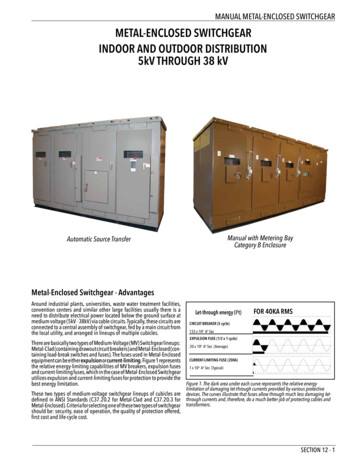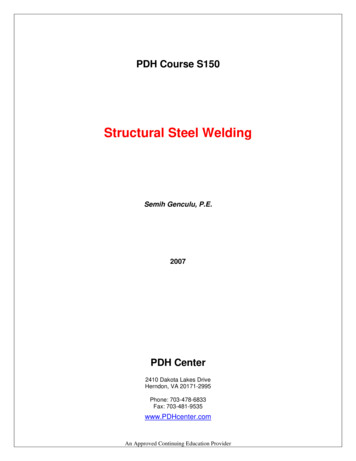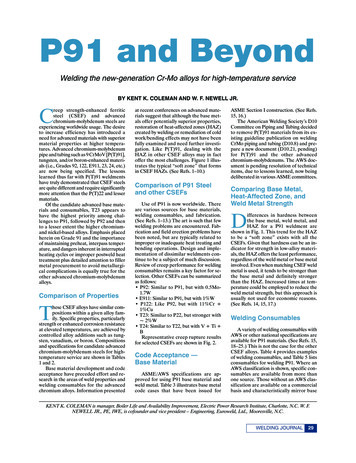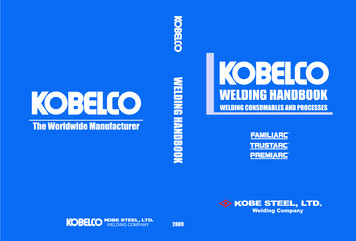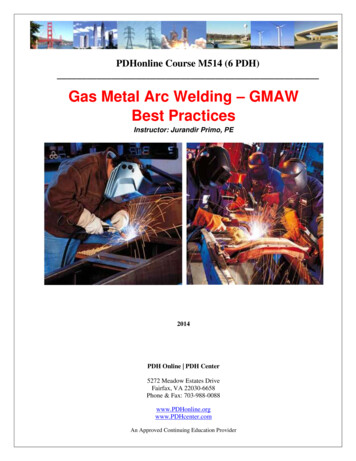
Transcription
PDHonline Course M514 (6 PDH)Gas Metal Arc Welding – GMAWBest PracticesInstructor: Jurandir Primo, PE2014PDH Online PDH Center5272 Meadow Estates DriveFairfax, VA 22030-6658Phone & Fax: 703-988-0088www.PDHonline.orgwww.PDHcenter.comAn Approved Continuing Education Provider
www.PDHcenter.comPDHonline Course M514www.PDHonline.orgGAS METAL ARC WELDING – GMAWBEST PRACTICESCONTENTS:1. INTRODUCTION2. GMAW DEVELOPMENT3. METAL TRANSFER VARIATIONS4. WELDING TORCHES AND ACCESSORIES5. WELDING CONTROL AND WIRE-FEEDING6. SHIELDING GASES – BEST PRACTICES7. BINARY SHIELDING GAS MIXTURE8. TERNARY SHIELDING GAS MIXTURE9. QUATERNARY SHIELDING GAS MIXTURE10. GMAW – WIRE ELECTRODES11. CARBON STEEL ELECTRODES12. STAINLESS STEEL ELECTRODES13. NON-FERROUS ELECTRODES14. FLUX-CORED CARBON STEEL ELECTRODES15. WELDING PARAMETERS AND TECHNIQUES16. WELDING POSITIONS17. GMAW – BEST PRACTICES18. WELD DEFECTS AND CORRECTIONS19. SETTING GMAW PARAMETERS20. IMPORTANT CORRECT PARAMETERS21. SUMMARY FOR GMAW BEST PRACTICES22. WELDING SAFETY23. BASIC GLOSSARY24. REFERENCES & LINKS 2013 Jurandir PrimoPage 1 of 63
www.PDHcenter.comPDHonline Course M514www.PDHonline.orgINTRODUCTION:GMAW or Gas Metal Arc Welding is also sometimes referred to by its subtypes, Metal InertGas (MIG) and Metal Active Gas (MAG). GMAW is a welding process in which an electric arc forms between a consumable wire electrode and the workpiece, which heats the workpiece metal(s), causing themto melt, and join. Along with the wire electrode, a shielding gas feeds through the welding gun, whichshields the process from contaminants in the air.Originally developed for welding aluminum and other non-ferrous materials in the 1940s, GMAW was soonapplied to steels because it provided faster welding time compared to other welding processes. The costof inert gas limited its use in steels until several years later, when the use of semi-inert gases suchas carbon dioxide became common.Further developments during the 1950s and 1960s gave the process more versatility and as a result, itbecame a highly used industrial process. Today, GMAW is the most common industrial welding process, preferred for its versatility, speed and the relative ease for adapting to robotic automation.Unlike welding processes that do not employ a shielding gas, such as shielded metal arc welding, it israrely used outdoors or in other areas of air volatility. A related process, Flux Cored Arc Welding, oftendoes not use a shielding gas, but instead employs an electrode wire that is hollow and filled with flux.GMAW DEVELOPMENT:The principles of Gas Metal Arc Welding began to be understood in the early 19th century, after HumphryDavy discovered the short pulsed electric arcs in 1800. Vasily Petrov independently produced the continuous electric arc in 1802 (soon followed by Davy). It was not until the 1880s that the technology becamedeveloped with the aim of industrial usage. At first, carbon electrodes were used in carbon arc welding.By 1890, metal electrodes had been invented by Nikolay Slavyanov and C. L. Coffin. In 1920, an earlypredecessor of GMAW was invented by P. O. Nobel of General Electric. He used a bare electrode wireand direct current, used arc voltage to regulate the feed rate, and did not use a shielding gas to protect theweld, as developments in welding atmospheres did not take place until later that decade. In 1926 anotherforerunner of GMAW was released, but it was not suitable for practical use.In 1948, GMAW was finally developed by the Battelle Memorial Institute. It used a smaller diameter electrode and a constant voltage power source developed by H. E. Kennedy. It offered a high deposition rate,but the high cost of inert gases limited its use to non-ferrous materials and prevented cost savings. In1953, the use of carbon dioxide as a welding atmosphere was developed, and it quickly gained popularityin GMAW, since it made welding steel more economical.In 1958 and 1959, the short-arc variation of GMAW was released, which increased welding versatility andmade the welding of thin materials possible while relying on smaller electrode wires and more advancedpower supplies. It quickly became the most popular GMAW variation. The spray-arc transfer variationwas developed in the early 1960s, when experimenters added small amounts of oxygen to inert gases.More re-cently, pulsed current has been applied, giving rise to a new method called the pulsed spray-arcvariation. 2013 Jurandir PrimoPage 2 of 63
www.PDHcenter.comPDHonline Course M514www.PDHonline.orgAs noted, GMAW is currently one of the most popular welding methods, especially in industrial environments. It is used extensively by the sheet metal industry and, by extension, the automobile industry.There is also the method often used for arc spot welding, thereby replacing riveting or resistance spotwelding. It is also popular for automated welding, in which robots handle the workpieces and the weldinggun to speed up the manufacturing process.Generally, it is unsuitable for welding outdoors, because the movement of the surrounding air can dissipate the shielding gas and thus make welding more difficult, while also decreasing the quality of theweld. The problem can be alleviated to some extent by increasing the shielding gas output, but this can beexpensive and may also affect the quality of the weld.In general, processes such as Shielded Metal Arc Welding (SMAW) and Flux-Cored Arc Welding (FCAW)are preferred for welding outdoors, making the use of GMAW in the construction industry rather limited.Furthermore, the use of a shielding gas causes GMAW to be unpopular for underwater welding.The Mig welding process operates on D.C. (direct current) usually with the wire electrode positive. This isknown as “reverse” polarity. The “straight” polarity is seldom used because of the poor transfer of moltenmetal from the wire electrode to the workpiece. Welding currents of from 50 amperes up to more than 600amperes are commonly used at welding voltages from 15V to 32V. A stable, self-correcting arc is obtained by using the constant potential (voltage) power system and a constant wire feed speed.Continuing developments have made the Mig process applicable to the welding of all commercially important metals such as steel, aluminum, stainless steel, copper and several others. Materials above 0.030 in.(0.76 mm) thick can be welded in all positions, including flat, vertical and overhead. It is simple tochoose the equipment, wire electrode, shielding gas, and welding conditions capable of producing highquality welds at a low cost.The basic GMAW process includes four distinctive process techniques: Globular Transfer, ShortCircuiting Transfer, Spray Arc Transfer, Pulsed-Spray and a special technique designated as Rotational Spray Transfer each of which has distinct properties and corresponding advantages and limitations. These techniques describe the manner in which metal is transferred from the wire to the weld pool. 2013 Jurandir PrimoPage 3 of 63
www.PDHcenter.comPDHonline Course M514www.PDHonline.orgMETAL TRANSFER VARIATIONS:Globular: GMAW with globular metal transfer is considered the least desirable of the three major GMAWvariations, because of its tendency to produce high heat, a poor weld surface, and spatter. The methodwas originally developed as a cost efficient way to weld steel using GMAW, because this variation usescarbon dioxide, a less expensive shielding gas than argon. Adding to its economic advantage was its highdeposition rate, allowing welding speeds of up to 110 mm/s (250 in/min).Globular transfer occurs when the drops of metal are quite large and move toward the weld pool under theinfluence of gravity. Factors that determine the manner of metal transfer are the welding current, wire size,arc length (voltage), power supply characteristics, and shielding gas. The process can be semi-automaticor automatic. A constant voltage, direct current power source is most commonly used with GMAW, butcurrent systems, as well as, alternating current, can be used.This mode of transfer generally is used on carbon steel only and uses 100 % CO2 shielding gas. The method is typically used to weld in the flat and horizontal positions because the droplet size is large andwould be more difficult to control if used in the vertical and overhead positions compared to the shortcircuit arc transfer. This mode generates more spatter; however, when higher currents are used withCO2 shielding and a buried arc, spatter can be greatly reduced. You must use caution with a buried arcbecause this can result in excessive reinforcement if travel speed isn't controlled.Stainless steel GMAW electrodes normally aren't used in globular transfer because their nickel andchrome content (9 to 14 % nickel and 19 to 23 % chromium) creates a higher electrical resistance thancarbon steel electrodes. In addition to the electrical resistance differences, the use of 100 % CO2 as ashielding gas could be detrimental to corrosion resistance of the stainless steel electrodes. Carbon steelER70S-3 and ER70S-6 generally are the electrodes of choice.As a result of the large molten droplet, the process is generally limited to flat and horizontal welding positions. The high amount of heat generated also is a downside, because it forces the welder to use a largerelectrode wire, increases the size of the weld pool, and causes greater residual stresses and distortion inthe weld area. When the droplet finally detaches either by gravity or short circuiting, it falls to theworkpiece, leaving an uneven surface and often causing spatter.Short-Circuiting: With an adequate adjustment can produce excellent bead appearance and is essentialfor stainless steel materials. The most predominant stainless steel electrodes are ER308L, ER 309L, andER 316L. These electrodes are also available in the Si type, such as, 308LSi. The LSi types contain moresilicon, which increases puddle fluidity and helps to weld better than the standard alloys. Further developments with GMAW led to a variation known as short-circuit transfer (SCT) or short-arc welding, inwhich the current is lower than the globular method. 2013 Jurandir PrimoPage 4 of 63
www.PDHcenter.comPDHonline Course M514www.PDHonline.orgThe short-circuiting metal transfer, also known as ”Short Arc”, ”Dip Transfer”, and ”Micro wire”, metaltransfer occurs when an electrical short circuit is established. This occurs as the molten metal at the endof the wire touches the molten weld pool. In spray arc welding, small molten drops of metal are detachedfrom the tip of the wire and projected by electromagnetic forces towards the weld pool.As a result of the lower current, the heat input for the short-arc variation is considerably reduced, making itpossible to weld thinner materials while decreasing the amount of distortion and residual stress in theweld area. This mode of transfer generally calls for smaller-diameter electrodes, such as, 0.023, 0.030,0.035, 0.040, and 0.045 in. The welding current must be sufficient to melt the electrode, but if it is excessive, it can cause a violent separation of the short electrode leading to excessive spatter.Using adjustable slope and inductance controls can enhance the transfer to minimize spatter and promotea flatter weld profile. Slope adjustment limits the short-circuit amperage, while inductance adjustmentscontrol the time it takes to reach maximum amperage. For carbon steel electrodes, the electrode classification dictates the silicon level, ER70S-3 and ER70S-6 as the most used. For pipe applications, ER70S-2,ER70S-4, and ER70S-7 are sometimes used for open-root work because they offer lower silicon levels.The lower silicon produces a stiffer puddle and gives you more control of the back bead profile. In anopen-root weld, you may use an S-6 type electrode with less inductance than an S-2 type electrodesince the S-6 type has higher level of silicon and the puddle is more fluid. Maintaining a constant contacttip-to-work distance in short-circuit transfer is important to maintain a smooth transfer. The most commonshielding gas and short-circuit transfer mode for carbon steel electrodes is 75 %-Ar and 25 % CO2.Many other three-part shielding gas mixtures are also available for carbon steel and stainless steel usingthis mode of transfer. This type of metal transfer provides better weld quality and fewer spatters than theglobular variation, and allows for welding in all positions, with slower deposition of weld material.Setting the weld process parameters (volts, amps and wire feed rate) within a relatively narrow band iscritical to maintaining a stable arc, generally between 100 to 200 amperes at 17 to 22 volts, for mostapplications. However, using only short-arc transfer can result in lack of fusion and insufficient penetration when welding thicker materials, due to the lower arc energy and rapidly freezing weld pool. Like theglobular variation, it can only be used on ferrous metals.Short-Arc Welding: This welding technique is particularly useful for joining thin materials in any position,thick materials in the vertical and overhead positions, and for filling large gaps. Uses small wire in therange of 0.030 in. (0.76 mm) to 0.045 in. (1.1 mm) diameter and operates at low arc lengths (low voltages) and welding currents. Short-arc welding should also be used where minimum distortion of the 2013 Jurandir PrimoPage 5 of 63
www.PDHcenter.comPDHonline Course M514www.PDHonline.orgworkpiece is a requirement. The metal is transferred from the wire to the weld pool only when contact between the two is made, or at each short circuit.The wire short circuits to the workpiece 20 to 200 times per second. To insure good arc stability, relatively low welding currents must be employed when using the short arc technique. The Table 1-1, below, illustrates the optimum current range for short circuiting metal transfer with several wire sizes. These rangescan be broadened, dep
7. binary shielding gas mixture 8. ternary shielding gas mixture 9. quaternary shielding gas mixture 10. gmaw – wire electrodes 11. carbon steel electrodes 12. stainless steel electrodes 13. non-ferrous electrodes 14. flux-cored carbon steel electrodes 15. welding parameters and techniques 16. welding positions 17. gmaw – best practices 18 .

